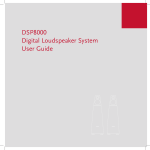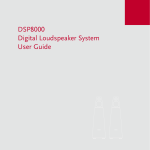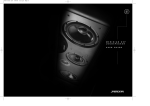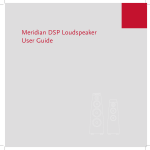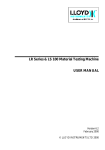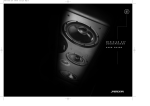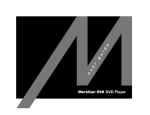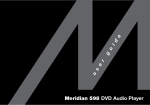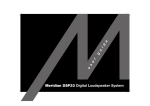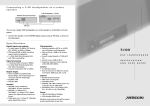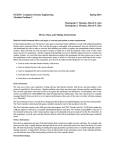Download Meridian DSP5500HC User guide
Transcript
8000 M E R I D I A N D S P L O U D S P E A K E R U S E R G U I D E Meridian DSP8000 Digital Loudspeaker System User Guide CD RADIO 1 2 LP TV TAPE 1 TAPE 2 CDR CABLE DVD VCR 1 Angle 4 5 6 7 8 9 Audio OSD T Slow Return Enter VCR 2 LD Repeat Off Record A-B Phase Subtitle Store 3 Menu Clear Volume Display Mute Setup Function 0 Title Preset Chapter Band i PREFACE Copyright and acknowledgements Sales and service in the UK Sales and service in the USA Meridian Audio Ltd Stonehill Stukeley Meadows Cambs PE29 6EX England Meridian America Inc 3800 Camp Creek Parkway Building 2400 Suite 122 Atlanta GA 30331 Tel (01480) 52144 Fax (01480) 459934 Tel (404) 344 7111 Fax (404) 346 7111 World Wide Web – http://www.meridian-audio.com Designed and manufactured in the UK by Digital Gramophone and Wireless Ltd Stonehill Stukeley Meadows Cambs PE29 6EX England Copyright © 2000 Digital Gramophone and Wireless Ltd. Part no: DSP8000U/1 Boothroyd|Stuart Meridian, Meridian, and used correctly in accordance with Meridian Digital Theatre, Meridian our instructions may cause interference Lossless Packing, MHR and MLP are to radio communications or radio and registered trademarks of Meridian television reception. It has been type- Audio Ltd. tested and complies with the limits set MHR: This product incorporates copyright protection technology covered by certain patent applications and intellectual property of Meridian Audio Ltd. This technology is provided for the out in Subpart J, Part 15 of FCC rules for a Class B computing device. These limits are intended to provide reasonable protection against such interference in home installations. express purpose of securely containing EEC: This product has been designed copyright audio within the Meridian and type-tested to comply with the System only. Reverse engineering or limits set out in EN55013 and EN55020. circumvention of this protection is strictly prohibited. FCC Warning: This equipment generates and can radiate radio frequency energy and if not installed ii This guide was produced by: Human-Computer Interface Ltd, http://www.interface.co.uk Contents Introduction 1 Meridian DSP8000 loudspeaker system 2 Sample configurations 5 Specification 6 Available accessories 8 Setting up the DSP8000 loudspeakers 9 Unpacking 10 Positioning the DSP8000 loudspeakers 13 Connecting the loudspeakers 14 Connecting to other equipment 15 Using the DSP8000 loudspeakers 19 Selecting a source 20 Changing the display 21 Adjusting the volume 22 Changing the tilt, bass or phase 23 Changing the listening position 24 Configuring the DSP8000 loudspeakers 25 Choosing standard settings 26 Specifying information about your system 28 Configuring the sources 29 Configuring the setup options 31 Troubleshooting 33 Troubleshooting 34 Maintenance and cleaning 36 Service and guarantee 37 iii Index 39 iv Introduction Welcome to the Meridian DSP8000 Digital Loudspeaker System! This User Guide provides full information about using the DSP8000 loudspeakers in conjunction with your other equipment, to achieve the superb results you can expect from them. CD RADIO 1 2 LP TV TAPE 1 TAPE 2 CDR CABLE DVD VCR 1 Angle 4 5 6 7 8 9 Audio OSD T Slow Return Enter VCR 2 LD Repeat Off Record A-B Phase Subtitle Store 3 Menu Clear Volume Display Mute Setup Function 0 Title Preset Chapter Band 1 INTRODUCTION Meridian DSP8000 loudspeaker system The Meridian DSP8000 loudspeaker system represents the fruits of more than 25 years of continuous development of loudspeakers as musical instruments. The finest materials and state-of-the-art design are combined to create what we believe is the ultimate home loudspeaker. Digital Signal Processing Digital Signal Processing, or DSP, is a technique pioneered by Meridian in hi-fi products for achieving extremely accurate reproduction of audio signals using high-precision mathematical processing. DSP allows sophisticated processing to be performed without any of the cumulative noise or degradation that inevitably occurs, even with highquality analogue circuitry. In addition, the signal improvement techniques incorporated in the Meridian DSP loudspeakers would be virtually impossible to implement in analogue circuitry. The Meridian DSP loudspeakers take advantage of DSP for several different functions: • To remove timing variations from the incoming digital signals (de-jittering). • To upsample 44.1kHz and 48kHz signals to 88.2kHz and 96kHz. • To split the frequency band between bass, mid-range, and treble drivers (crossover). • To perform filtering or adjustment of the frequency response; eg treble or bass. • To provide volume control to 48-bit precision. • To provide digital protection of the loudspeakers against high-level lowfrequency transients. • To perform electronic equalisation. If you are using the Meridian DSP loudspeakers with a digital source, such as CD or DVD, the signals remain in digital form until the last possible stage. DSP loudspeaker drivers Each DSP8000 loudspeaker uses six multiple high-efficiency long-throw custom bass drive units. The bass units are mounted symmetrically in pairs on the sides of the bass cabinet, cancelling vibration in order to minimise interference with the mid-range and treble units. 2 INTRODUCTION The treble and mid-range drivers are mounted in a separate sealed head assembly. The treble unit is a semi-horn-loaded composite dome design with a silver voice coil. The mid-range unit incorporates a cone made from a uniquely light and stiff combination of polymers to give unparalleled transparency. Power amplifiers The speakers are driven by five independent high-power low-feedback power amplifiers mounted on a multi-finned extruded heatsink. The combination of idealised magnetic design, careful star earthing, and very fast output devices gives the amplifiers extremely low noise, high detail, and fast bass. The whole electronic assembly is supplied from two substantial toroidal transformers feeding high-quality audiophile-grade capacitors. Cabinet Each DSP8000 loudspeaker is built around a precision manufactured cabinet, which uses innovative design techniques to give exceptionally low coloration and amazing mid-range transparency. The head assembly is a sealed enclosure fabricated from curved pressurelaminated panels, each using multiple layers of selected woods and metal to provide high stiffness and damping. Its narrow tapered shape offers optimum dispersion across a wide listening area. It is supported on the bass enclosure by three machined feet. Like the head unit, the bass cabinet is constructed from interlaminated panels with extensive bracing. The front panel is 6mm glass and incorporates a window for the matrix display and infrared remote control sensor. The cabinet stands on triangulated adjustable machined foot assemblies with provision for floor spikes or skids. Meridian High Resolution (MHR) The DSP8000 loudspeakers support Meridian High Resolution (MHR), to allow you to connect to other MHR-compliant Meridian products to take advantage of high-rate audio sources, and provide the additional benefits of lower jitter and improved sound quality on all sources. MHR is a proprietary secure encoding format that uses encryption and anticopy methods to provide a secure copyright protection environment, and allow the secure transfer of audio streams within a Meridian-only system for playback only. 3 INTRODUCTION Meridian Comms The Meridian DSP loudspeakers are part of the Meridian family of advanced digital, analogue, and video components, and these incorporate a sophisticated communications link, to allow you to control any combination of units using a single remote, and ensure that they will work together as a fully integrated system. The communications system also allows you to extend your hi-fi system into two or three rooms, with the ability to control the sources in one room from the controller in another room. The following page shows two recommended configurations based on the Meridian DSP8000 loudspeakers to illustrate the flexibility of Meridian components. 4 INTRODUCTION Sample configurations Meridian Digital Theatre™ DSP8000 DSP8000 DSP8000 DSP8000 DSP5500HC Meridian 861 Reference Digital Surround Controller Meridian 800 Reference DVD/CD Player Up to seven Meridian DSP8000 loudspeakers can be used in conjunction with a Meridian Surround Processor to create a digital surround system with superb music and cinema sound. The Meridian DVD Player is an ideal source for use with DSP loudspeakers. It allows you to play both audio CDs and DVD movies, with the audio kept in digital form until the last possible stage. Meridian Digital Music System DSP8000 DSP8000 Meridian 800 Reference DVD/CD Player Meridian DSP loudspeakers include DSP volume and tone controls, and can be connected directly to up to two digital sources to create an extremely compact high-quality music system. 5 INTRODUCTION Specification Digital inputs and outputs • 2 x cable digital inputs, 75Ω, IEC958, 44.1-96kHz. FIFO locks at 44.1, 48, 88.2, or 96kHz ± 150ppm, PCM or MHR encoding. • 176.4kHz or 192kHz supported with special firmware and cabling; details available on request. • 1 x cable digital output, 75Ω, IEC958, providing a copy of the selected input. Signal processing • 2 x Motorola 56366 running at 100MHz. • 4 x 192kHz/24-bit Delta-Sigma DACs. • Crossovers linear-phase ±30º at 200Hz and 2.6kHz. Output stages • Power amplifiers: Complementary bipolar design, with output-stage error correction and low feedback design. • Bass: 3 x 150W RMS. • Mid: 100W RMS. • Treble: 100W RMS. Acoustic 3 Qw way. Closed bass enclosure. Separate mid/top plywood cabinet. Bass drive unit: 6 x 200mm (8") high-efficiency long-throw custom drivers. • Mid drive unit: 1 x 160mm (6") custom driver. • Treble drive unit: 1 x 25mm (1") Meridian piston in short horn, composite dome with silver voice-coil. • • • • Characteristics • Distortion typically <0.01%, or <0.02% up to full power at all frequencies. • Noise and hum <-94dBr at all volume settings. • Acoustic output typically >115dB spl @ 1m. • Acoustic noise <15dB spl @ 1m. • Frequency response in room response within 3dB, 25Hz-35kHz. Control • 2 x Meridian Comms. • 9-pin D connector for RS232 PC setup and control, null modem, 9600 baud, 2N1, no handshake. 6 INTRODUCTION Cabinet • • • • Entire speaker manufactured from interlaminated panels. Glass front. Finished in high-gloss black piano lacquer. 400mm x 1300mm x 528mm (15.7" x 51.2" x 20.8") (W x H x D excluding feet). • 105kg (231lb) each. Power • 100-125; 200-250V AC 50-60Hz. • 20VA idle; 900VA max. Meridian Audio reserves the right to amend product specifications at any time. 7 INTRODUCTION Available accessories Each pair of DSP8000 loudspeakers is shipped with a Meridian System Remote and cables to enable them to be used as the front speakers in a Meridian Digital Theatre with a Meridian DVD Player (such as the 800) or a Meridian Digital Surround Controller (such as the 861, 568, or 561). Other applications, and some advanced features, may require one or more of the following accessories, which can be purchased from your Meridian dealer. • Additional S5 leads (8m and 14m). • 511 S-patch box if connecting more than two DSP loudspeakers to a 561 Digital Surround Controller or 568 Digital Surround Processor (not required with 861). 8 Setting up the DSP8000 loudspeakers This chapter explains how to install your DSP8000 loudspeakers. It describes what you should find when you unpack the speakers, how you should connect them to your other audio equipment, and the siting constraints. CD RADIO 1 2 LP TV TAPE 1 TAPE 2 CDR CABLE DVD VCR 1 3 Angle 4 5 6 7 8 9 Audio OSD T Slow Return Enter VCR 2 LD Repeat Off Record A-B Phase Subtitle Store Menu Clear Volume Display Mute Setup Function 0 Title Preset Chapter Band 9 SETTING UP THE DSP8000 LOUDSPEAKERS Unpacking Before you begin installation you should ensure that your DSP8000 loudspeakers are the correct voltage for your local AC supply. If they are not, do not try to install them, and contact your dealer. You should not make any connections to the DSP8000 loudspeakers, or to any other component in your system, while the AC power supply is connected and switched on. Care when unpacking Take great care when unpacking or re-packing the DSP8000 loudspeakers that you do not put undue pressure on the side containing the drive units, as they may be damaged if pressed. Components Each pair of DSP8000 loudspeakers is supplied with the following components: • • • • • • • • • • • • The DSP8000 loudspeakers. Grilles packed separately. Six foot-mounting plates, spike clamps, spikes, and spike protectors. Four stabilisers. A hex wrench (3mm) for the drive units. A 10mm spanner for removing the headboard and footboard. Six shouldered spikes for the head unit. Meridian System Remote, battery and user guide. One power cord per speaker suitable for your territory. Meridian M5 lead (8 metres). Meridian S5 lead (8 metres). This user guide. You will also need a No. 2 Pozidriv screwdriver to attach the foot mounting plate. If any of these items is missing, please contact your dealer. We suggest that you retain the packaging carefully, as it provides maximum protection in transit. Unpacking To unpack the DSP8000 loudspeakers please follow the instructions on the enclosed leaflet. 10 SETTING UP THE DSP8000 LOUDSPEAKERS Caution Meridian Audio has taken every care in the design, assembly, finishing and packing of this product. The high gloss finish on parts of the cabinet is achieved by painting up to five coats of polyester lacquer onto the plywood, each one hand polished. Due to the product size and high technology cabinet construction, small marks on the lacquer surface may be visible when unpacked. These small marks can usually be removed as described in Maintenance and cleaning, page 36. It is the nature of all lacquer finishes to shrink over time. This is unavoidable and may result in cabinet joint lines becoming visible. Meridian Audio has supplied products using lacquer finishes for many years and we are confident that when carefully used your product will return a lifetime’s enjoyment. Tightening the drive units The DSP8000 loudspeakers typically take about two weeks of normal use for the drive units to settle. It is therefore recommended that you leave the grilles unfitted during this period, and tighten the mounting bolts on each drive unit every few days. Tighten the bolts in symmetrically opposite pairs using the 3mm hex wrench provided. You should then check and if necessary retighten the drive units every few years. To dismantle the loudspeakers It is advisable to remove the head units when moving the speakers. This is achieved by disconnecting the head lead from the head unit and lifting off the head. Take care while the head is not in position as this exposes its mounting spikes. While not in place the head should be stored safely but care should also be taken of the surface they are placed upon as it may be damaged by the cups. When dismantling the speakers always disconnect and switch the power off first. Note: Do not disconnect the head lead while the unit is connected to the AC supply and switched on. 11 SETTING UP THE DSP8000 LOUDSPEAKERS Radio interference FCC Warning: This equipment generates and can radiate radio frequency energy and if not installed and used correctly in accordance with our instructions may cause interference to radio communications or radio and television reception. It has been type-tested and complies with the limits set out in Subpart J, Part 15 of FCC rules for a Class B computing device. These limits are intended to provide reasonable protection against such interference in home installations. EEC: This product has been designed and type-tested to comply with the limits set out in EN55013 and EN55020. 12 SETTING UP THE DSP8000 LOUDSPEAKERS Positioning the DSP8000 loudspeakers Safety warnings • Do not expose the speakers to dripping or splashing. • Do not place any object filled with liquid, such as a vase or plant pot, on the speakers. • Do not place naked flame sources, such as lighted candles, on the speakers. To avoid overheating Do not position the speakers: • In direct sunlight. • Near heat sources, such as a radiator. • Directly on top of heat producing equipment. The back panel of the DSP8000 loudspeaker acts as a heatsink and requires adequate ventilation. Ensure that air can flow around it. The heatsink normally runs warm to the touch when the speakers are not in standby. To obtain the best sound For best results adjust the position of the loudspeakers while listening to music. If possible, have the most acoustically absorbent wall in the room behind the front speakers. Ideally have each DSP8000 loudspeaker at least 0.5m (20") from a corner, and position them approximately 0.25m (10") from the wall. If you are using a DSP8000 loudspeaker as a centre channel, place the speaker centrally between the main left-right pair and, if possible, arrange for the treble units of the three speakers to be approximately the same height. 13 SETTING UP THE DSP8000 LOUDSPEAKERS Connecting the loudspeakers Back panel The following diagram gives details of the back panel connections: Digital inputs DIGITAL INPUT 2 1 Digital output DIGITAL OUTPUT Comms MERIDIAN COMMS OUTPUT INPUT PC RS232 Digital connections The following table gives details of the digital audio connections: Use this connection To connect to this DIGITAL INPUT 1, DIGITAL INPUT 2 A digital source, such as a digital sound processor digital preamplifier, CD player or DVD player. DIGITAL OUTPUT A second (slave) DSP loudspeaker, using an S5 lead. The digital connections should be made with high-quality 75Ω screened cable. Suitable cables are available from Meridian. We do not recommend using audio cables, which do not have adequate shielding or the correct impedance, or cables intended for UHF applications, as these do not provide adequate shielding in the 1–30MHz region. Communications connections The following table gives details of the communications connections: Use this connection To connect to this COMMS INPUT The COMMS connection on a Meridian control unit or preamplifier. COMMS OUTPUT The COMMS INPUT on a second DSP loudspeaker. RS232 The serial port of a PC, to control the DSP loudspeaker using a computer. For more information see the Meridian Web site, http://www.meridian-audio.com. 14 SETTING UP THE DSP8000 LOUDSPEAKERS Connecting to other equipment To connect two DSP loudspeakers in a Meridian system 562V.2 Multimedia Controller DIGITAL COMMS OUTPUT M5 lead DSP loudspeaker – Main R DIGITAL INPUT 2 1 DSP loudspeaker – Main L DIGITAL COMMS OUTPUT OUTPUT INPUT DIGITAL INPUT 2 1 DIGITAL COMMS OUTPUT OUTPUT INPUT S5 lead You can connect two DSP loudspeakers directly to a Meridian CD or DVD player, Digital Surround Processor, or Meridian 562V.2 Multimedia Controller. • Connect one of the COMMS sockets on the Meridian source or control unit, and the MAIN digital output, to one of the speakers using the M5 lead supplied. • Link the two DSP loudspeakers together using the S5 lead supplied, as shown in the illustration. To use a DSP loudspeaker as a centre speaker Meridian Surround Processor CENTRE DIGITAL COMMS OUTPUT M5 lead DSP loudspeaker – Centre DIGITAL INPUT 2 1 DIGITAL COMMS OUTPUT OUTPUT INPUT You can use a single DSP loudspeaker as a centre speaker in a Meridian surround system. • Connect the speaker to the CENTRE digital output using an M5 lead, as shown in the illustration. 15 To connect three or more DSP loudspeakers in a Meridian surround system DIGITAL COMMS OUTPUT OUTPUT INPUT DSP loudspeaker Centre (master) DIGITAL INPUT 2 1 SETTING UP THE DSP8000 LOUDSPEAKERS Meridian Surround Processor COMMS DIGITAL OUTPUTS M5 lead 511 S-patch box DSP loudspeaker – Main R DIGITAL INPUT 2 1 S5 lead S5 lead (digital unused) DIGITAL COMMS OUTPUT OUTPUT INPUT DSP loudspeaker – Main L DIGITAL INPUT 2 1 DIGITAL COMMS OUTPUT OUTPUT INPUT S5 lead If your system includes more than two Meridian DSP loudspeakers you may need a 511 S-patch box (available separately) to link together the S5 leads from each speaker, as shown above. • Use the comms part of an M5 lead to connect one of the COMMS sockets on the Meridian Surround Processor to the DSP loudspeaker you have chosen as the master (typically the centre speaker). • Use the audio part of the M5 lead to connect the DSP loudspeaker to the appropriate digital output on the Meridian Surround Processor. • Connect the COMMS output from the master DSP loudspeaker to one socket on the 511 using an S5 lead. • Link all the other DSP loudspeakers together in pairs using S5 leads, as shown in the illustration. • Connect each pair of DSP loudspeakers to the appropriate digital output on the Meridian Surround Processor, using an S5 lead. The other part of the S5 lead is used to distribute the COMMS from the 511 to each pair of DSP loudspeakers. 16 SETTING UP THE DSP8000 LOUDSPEAKERS To connect two DSP loudspeakers to a Meridian CD Player or other digital source 508.24 24-Bit CD Player DIGITAL COMMS OUTPUT M5 lead DSP loudspeaker – Main R DIGITAL INPUT 2 1 DSP loudspeaker – Main L DIGITAL COMMS OUTPUT OUTPUT INPUT DIGITAL INPUT 2 1 DIGITAL COMMS OUTPUT OUTPUT INPUT S5 lead You can create a complete system by connecting a pair of DSP loudspeakers directly to a digital source. The DSP loudspeakers include volume, balance, and tone controls allowing you to control the system using the Meridian System Remote. • Connect one of the COMMS sockets on the Meridian source, and the digital output, to one of the DSP loudspeakers using the M5 lead. • Link the two DSP loudspeakers together using the S5 lead, as shown in the illustration. You can connect another digital source to DIGITAL INPUT 2, and then configure the appropriate source selection key on the remote to select that input; see Configuring the sources, page 29. See the chapter Using the DSP8000 Loudspeakers, page 19, for information about controlling the DSP loudspeakers. 17 SETTING UP THE DSP8000 LOUDSPEAKERS 18 Using the DSP8000 loudspeakers In systems with a Meridian preamplifier or control unit all of the functions of the DSP8000 loudspeakers, including volume, tilt, and bass, are operated via the controller. For more information refer to the user guide for the preamplifier or control unit, and you can ignore this chapter. However, the DSP8000 loudspeakers can also be connected directly to up to two digital sources to create a complete, minimum system. This chapter provides step-by-step instructions for operating the DSP loudspeakers in a system with no Meridian preamplifier or control unit. CD RADIO 1 2 LP TV TAPE 1 TAPE 2 CDR CABLE DVD VCR 1 3 Angle Audio OSD 6 Record 4 5 7 8 9 Function 0 Title Preset Chapter Band Subtitle T Slow Return Enter Menu VCR 2 LD Repeat Off A-B Phase Store Clear Volume Display Mute Setup 19 USING THE DSP8000 LOUDSPEAKERS Selecting a source When not playing, the DSP8000 loudspeakers should be left in the standby state. This uses a negligible amount of electricity, but ensures that the components of the loudspeakers operate at maximum efficiency from the moment you start. If you are not going to use the DSP8000 loudspeakers for several days you should switch each unit completely off at the back panel, and disconnect it from the AC power supply. To select a source • Press the appropriate source key on the remote; eg Radio. This will bring the DSP8000 loudspeakers out of standby, and the displays will show the currently selected source and volume setting. Radio 65 For example: By default the 12 sources shown below are available. As standard, all the sources are set to select the D1 digital input. To select the D2 input, see To configure a source, page 29. Source Label Source Label CD CD CDR CDR Radio Radio Cable Cable LP LP DVD DVD TV TV Cable Cable Tape1 Tape1 VCR1 VCR1 Tape2 Tape2 LD LDisc To switch to standby • Press Off on the remote. The loudspeakers will switch to standby and the displays will show: 20 . USING THE DSP8000 LOUDSPEAKERS Changing the display The DSP8000 loudspeakers display information about the current settings on the 8-character front-panel display. In addition, three coloured indicators show status information. To change the displayed information • Press Display. Pressing Display steps between the following options: Display option Example Source and volume Radio 65 Meridian source display (dashes if not present) ---- Audio format PCM 96k Blank The audio format display shows PCM, Data, or MHR followed by the frequency, or NL (not locked). Status indicators The display includes the following status indicators: Indicator Description Red Master loudspeaker. Yellow 88kHz or 96kHz input. Green Clipping; see Troubleshooting, page 33. 21 USING THE DSP8000 LOUDSPEAKERS Adjusting the volume The DSP8000 loudspeakers adjust the volume in precise steps of 1dB, where 9dB is equivalent to doubling the loudness, and can be varied in the range 1 to 99dB. When you first connect power to the DSP8000 loudspeakers the volume is set to 65, which is similar to the midway position of the rotary volume control on a conventional preamplifier. To change the volume • Press the red A or V keys on the remote. As you adjust the volume setting the display will show the current volume level: Radio 55 To mute the sound • Press Mute on the remote. Muted The display will show: To restore the sound • Press Mute again on the remote. Alternatively, the sound will be restored if you adjust the volume. 22 USING THE DSP8000 LOUDSPEAKERS Changing the tilt, bass or phase The DSP loudspeakers provide sophisticated tilt and bass controls, to allow you to adjust the broad balance of the system to correct for the acoustics of your listening room, or for a misbalanced recording. The controls are more subtle than conventional tone controls, and take advantage of digital signal processing techniques to provide a more natural adjustment of the frequency response. You can also change the absolute phase of the signal, to compensate for signals which are out of phase, giving an unnatural-sounding bass. To change the tilt • Press < or > until the display shows the current tilt. Tilt+0.0 For example: • Press A or V to change the tilt. The tilt control tilts the frequency of the response over the entire frequency range to make the sound brighter or dimmer. It can be adjusted between ±10db in 0.5dB steps. Normally settings between +1.0 and -2.0 will give the most natural results. To change the bass • Press < or > until the display shows the current bass setting. Bass+0.0 For example: • Press A or V to change the bass. The bass control allows you to adjust the bass response in the room by ±5dB in 0.5dB steps. Normally settings between +3.0 and -2.0 will give the most natural results. To change the absolute phase • Press > or < until the display shows the current phase. Phase For example: • Press A or V to change the phase. 23 + USING THE DSP8000 LOUDSPEAKERS Changing the listening position The balance control of the DSP8000 loudspeakers uses digital signal processing to compensate for an off-centre listening position by delaying and diminishing the sound in one speaker, thus effectively shifting the speaker’s image back. The axis control allows you to adjust the optimum listening height of the DSP8000 loudspeakers, like a balance control operating in the vertical plane. To change the balance • Press < or > on the remote until the display shows the current balance. Bal. <0> For example: • Press A or V to change the balance. The display shows the direction and position of the listening position. Bal. 12> For example: There are 32 steps in each direction. To change the axis • Press < or > on the remote until the display shows the current axis setting. Axis For example: -1 • Press A or V to change the axis. The axis can be adjusted between 3 and -2, where 0 corresponds to the axis of the treble unit. Usually a listener will be below that position, so we recommend settings of -1 or -2. To restore flat settings • Press Clear on the remote. Reset The display shows: This restores the balance, axis, tilt, and bass to zero. 24 Configuring the DSP8000 loudspeakers This chapter explains how to configure the DSP8000 loudspeakers to suit the other equipment in your system. The first stage in configuring the DSP8000 loudspeakers is to choose one of the standard settings, and these are designed to set all of the parameters to their most common values. You can also configure each setting individually for applications not catered for by one of the standard settings. Once you have configured the DSP8000 loudspeakers you will probably never need to change the configuration, unless you alter the equipment connected to your system at a later stage. CD RADIO 1 2 LP TV TAPE 1 TAPE 2 CDR CABLE DVD VCR 1 3 Angle Audio OSD 6 Record 4 5 7 8 9 Function 0 Title Preset Chapter Band Subtitle T Slow Return Enter Menu VCR 2 LD Repeat Off A-B Phase Store Clear Volume Display Mute Setup 25 CONFIGURING THE DSP8000 LOUDSPEAKERS Choosing standard settings The DSP8000 loudspeakers provide the following five alternative standard settings, called Types, which configure all aspects of the loudspeaker into the most commonly needed configurations: Type Description 1 For use with a Meridian control unit such as the 562V.2. 5 For use with a CD player connected to D1; all other sources use D2. 6 For use with a Meridian Surround Controller. 7 For use in a second room. 8 For use in the second or third room of a three-room system. Types 2, 3, and 4 are for compatibility with 200/600 series units. In all cases except Type 5, the D1 input is used for all sources. Choosing one of the standard settings overrides any other configuration you may have performed, and so can be used to reset the configuration of the speakers. To select a standard setting • Switch off the DSP loudspeaker. • Turn on the power again while holding down the 1 key on the remote. The display will show the Type number. Type 1 For example: • Release the remote key. L. The display will show: You should now specify the speaker’s position as follows. 26 CONFIGURING THE DSP8000 LOUDSPEAKERS To specify the speaker position • Press A or V to specify the speaker position. The options are shown in the following table: Display Position L. Left. R. Right. C. Centre (Type 6 only). S.L. Left surround (Type 6 only). S.R. Right surround (Type 6 only). To choose master or slave You should select one loudspeaker to be the master; this will normally be the centre channel. See Setting up the DSP8000 loudspeakers, page 9. The other DSP8000 loudspeakers should be configured as slaves as follows. • Press the green > (Play) key on the remote. The display shows, for example: L. Slv. When you have configured the loudspeaker: • Switch off the DSP8000 loudspeaker, using the power switch on the back, and then switch on again to restore normal operation. 27 CONFIGURING THE DSP8000 LOUDSPEAKERS Specifying information about your system You can configure the operation of the DSP8000 loudspeakers to suit the way your system is set up, and the way in which you want to use it. These settings are configured automatically to appropriate values when you choose one of the standard Type settings, and you should not normally need to alter them; see Choosing standard settings, page 26. To configure the DSP8000 loudspeaker • Turn off the DSP loudspeaker, using the power switch on the back panel. • Turn on the power again while holding down the 0 key on the remote. The display will show the current setting of the first configuration option. L. For example: • Press > or < to step between the options. • Press A or V to change the value of the current option. The table below shows the options you can configure. Option Initial Value Position and master/slave L. Communications mode (500 or 200) 500 Controller mode (Auto, Con, or NCon) Auto System address (1–8) S.A. 1 Product address (1–8) P.A. 1 L.E. 1 Balance control? (N or Y) Bal. Y Centre menus? (N or Y) Centre N Diagnostic displays? (N or Y) Diag. Volume mode (1=normal, 2/3=second/additional room) 28 N CONFIGURING THE DSP8000 LOUDSPEAKERS Configuring the sources When the master DSP8000 loudspeaker is set to one of the standard Types the 12 source selection keys on the remote select inputs D1 and D2 as shown in the table on page␣ 30. If the configuration you want is not catered for by one of the standard settings, you can configure each source individually. The DSP loudspeakers provide 12 sources corresponding to the 12 source selection keys on the remote: CD, Radio, LP, TV, Tape1, Tape2, CDR, Cable, DVD, VCR1, VCR2, and LD. For each source you can configure: • The label used for it on the front panel display, from a range of alternative labels. • The digital input it selects. • The comms type and address, to identify other Meridian 500 Series equipment. • Other advanced options. You only need to configure the sources on the DSP loudspeaker you have specified as the master. To configure a source While in configuration mode: • Press the source key on the remote corresponding to the source you want to configure. For example, to configure the Radio source the display initially shows: RD Radio • Press > or < to step between options. The right-hand set of characters shows the current value of the option. • Press A or V to change the value of the option. When you have finished programming sources: • Switch off at the back panel, and then switch on again to restore normal operation. 29 CONFIGURING THE DSP8000 LOUDSPEAKERS The options are summarised in the table below: Option Initial value Alternatives Explanation CD, Radio, LP, etc. The label used to identify the source on the front-panel display. Label Radio Audio input D1 D1 or D2. Choose D1 or D2 to specify the input. Comms type 2C 1C – 9C, or NC. Choose 1C for a Meridian CD player, 2C for a Meridian FM Tuner, 3C for a Meridian DVD player, or NC otherwise. Address 1A 1A – 8A. Allows you to have up to eight of each source type. FIFO FF. Y Y or N. Choose N to disable the FIFO buffer if you have difficulty locking to a poor source. 30 CONFIGURING THE DSP8000 LOUDSPEAKERS Configuring the setup options The setup option allows you to add a tilt offset to the centre speaker. You only need to configure the master loudspeaker. To select Setup mode • Turn off the DSP8000 loudspeaker using the power switch on the back panel. • Turn on the power again while holding down the Store key on the remote. Setup The display will show: It will then revert to standby: . You can now operate the speaker in the usual way, using the additional setup menu to adjust the response while listening to sources. When you have finished adjusting the setup options: • Switch off at the back panel, and then switch on again to restore normal operation with the setup you have programmed. To adjust the centre tilt offset If your system includes a DSP centre speaker you should set Centre Y on the master speaker. An additional centre tilt offset option is then provided to allow you to add a tilt offset to the centre speaker. • Press > or < until the display shows the current centre tilt offset. C.Tilt+1 For example: • Press A or V to adjust the centre tilt offset. The Centre tilt offset is added to the Tilt value for the selected source. The recommended setting is -1dB. 31 CONFIGURING THE DSP8000 LOUDSPEAKERS To store the settings Once you have adjusted the centre tilt offset you should store the setting using the following procedure: • Press the Store key on the remote. Store The display shows: • Turn off the DSP8000 loudspeaker using the power switch on the back panel. When you turn on the power again the speaker will operate normally with the setting you have stored. 32 Troubleshooting This chapter provides suggested solutions to typical problems that may occur when setting up the DSP8000 loudspeakers. If you are still not able to resolve a difficulty with the help of this guide and the suggestions in the following pages, please contact your Meridian dealer or Meridian Audio Ltd. CD RADIO 1 2 LP TV TAPE 1 TAPE 2 CDR CABLE DVD VCR 1 3 Angle Audio OSD 6 Record 4 5 7 8 9 Function 0 Title Preset Chapter Band Subtitle T Slow Return Enter Menu VCR 2 LD Repeat Off A-B Phase Store Clear Volume Display Mute Setup 33 TROUBLESHOOTING Troubleshooting Display on front panel not lit Check the following: • There is AC power connected to the socket on the back of the DSP8000 loudspeaker. • The power switch on the back panel of the DSP8000 loudspeaker is turned on. If the display will still not illuminate, check any fuses in your power supply and the fuse in the inlet of the DSP8000 loudspeaker. If these are all intact, contact your dealer. Remote not working Check the following: • The battery in the Meridian System Remote. • See if the DSP8000 loudspeaker has been set up as not controller in the Meridian Configuration program; see Configuring the setup options, page 31. Note that this may be deliberate by your dealer. Unit goes silent when played hard • The DSP8000 loudspeakers have a temperature sensing system on board, which prevents overheating of the electronics. The sound will continue when the speaker has cooled. There is radio interference The DSP8000 loudspeaker is a digital audio and computing device which has been designed to very high standards of electromagnetic compatibility. If this equipment does cause or suffer from interference to/from radio or television reception then the following measures should be tried: • Reorient the receiving aerial (or antenna) or route the antenna cable of the receiver as far as possible from the DSP8000 loudspeaker and its cabling. • Ensure that the receiver uses well-screened antenna cable. • Relocate the receiver with respect to the DSP8000 loudspeaker. • Connect the receiver and this product to different AC outlets. • If the problem persists contact your dealer. 34 TROUBLESHOOTING Drive units move when the speaker is switched on or off • This is normal as the speaker active electronics settle. Configuring the DSP8000 loudspeaker does not have any effect Make sure that you are configuring the DSP8000 loudspeaker used as the master digital loudspeaker in the system. This determines the configuration of all digital loudspeakers in the system. Unit stays in standby • Check that it is connected correctly. • Turn the system on from another Meridian product in the system. Only the master loudspeaker plays • Check the S5 cables are connected correctly. Sound is odd or mono • Check that the DSP8000 loudspeakers are correctly configured as Left and Right respectively. The yellow indicator flashes or stays on This indicates that DSP clipping is occurring. Brief flashes indicate occasional clipping which will not be audible. If the indicator stays on for long periods this may indicate a fault in the configuration of your system, and you should contact your Meridian dealer. 35 TROUBLESHOOTING Maintenance and cleaning Fitting and removing the grilles When fitting the grilles ensure that the two cutouts are at the 3 o‘clock and 9 o‘clock positions, as this will align the pattern on the grille fabric correctly. To remove the grilles grasp the grille by the two cutouts and pull gently away from the loudspeaker. Cleaning Small marks on the lacquer surface can usually be removed by treating with Black Turtle Wax Color Magic. Do not use any coarse polish such as Auto Colour Restorer, and always test any polish on a non-visible area first. Do not use any polish containing a solvent; these can cause crazing of the surface. Deeper scratches can be removed by treating with additional polyester lacquer filler and then polishing carefully. Consult your authorised Meridian dealer for advice before attempting any repair. 36 TROUBLESHOOTING Service and guarantee Service The Meridian components have been carefully designed to give years of untroubled service. There are no user-serviceable parts inside the case, nor do the units require any form of maintenance. In the unlikely event that your DSP loudspeaker fails to function correctly, it should be returned, in its original packaging, to your Meridian dealer. In case of difficulty within the UK or USA please contact the appropriate sales and service address shown on page ii. In case of difficulty outside the UK or USA, contact the importing agent for the territory. A list of Meridian agents abroad is available from Meridian Audio. No responsibility can be accepted for the DSP8000 loudspeakers whilst in transit to the factory or an agent, and customers are therefore advised to insure the unit. When seeking service under guarantee, proof of the date of purchase will be required. Guarantee The DSP8000 Loudspeakers are guaranteed against defects in material and workmanship for two years from the date of purchase. The guarantee is void if the DSP8000 Loudspeakers have been subject to misuse, accident, or negligence, or has been tampered with or modified in any way without the written authorisation of Meridian Audio Limited. Note that connecting anything other than the correct network lead to the COMMS sockets may cause damage to the DSP8000 Loudspeakers which will not be covered by this guarantee. Attempted servicing by unauthorised people may also invalidate this guarantee. Labour and carriage charges are not covered unless by local agreement. Outside the UK, local warranty liability is restricted to equipment purchased within the territory. Our agents abroad are only under contractual obligation to service under guarantee equipment sold through them. They are entitled to make a non-refundable charge for any service carried out on other equipment. This guarantee does not limit your statutory rights within the United Kingdom. 37 TROUBLESHOOTING 38 Index A absolute phase, changing accessories axis, changing connections (continued) digital inputs digital output RS232 23 8 24 D B back panel balance, changing bass, changing digital inputs digital output digital signal processing dismantling the loudspeakers display, changing drive units tightening 14 24 23 C centre tilt offset, adjusting cleaning COMMS INPUT COMMS OUTPUT communications connections components configuration options balance control centre menus communications mode controller mode diagnostic displays position and master/slave product address system address volume mode configuring setup options configuring sources address audio input comms type FIFO label configuring the loudspeakers connecting the loudspeakers connecting to other equipment connections COMMS INPUT COMMS OUTPUT communications 14 14 14 31 36 14 14 14 10 28 28 28 28 28 28 28 28 28 28 31 29 30 30 30 30 30 28 14 15 14 14 14 14 14 14 2 11 21 3 11 G grilles, fitting and removing guarantee 36 37 L lacquer finish polishing listening position, changing 11 36 24 M maintenance master, selecting Meridian comms Meridian Digital Music System Meridian Digital Theatre™ Meridian High Resolution (MHR) muting the sound 36 27 4 5 5 3 22 P positioning the loudspeakers 13 R radio interference 12, 34 S safety warnings sample configurations Meridian Digital Music System Meridian Digital Theatre™ 39 13 5 5 selecting a source service settings, storing Setup mode, selecting setup options, configuring slave, selecting sources configuring selecting speaker position, specifying specification standard settings, selecting standby, switching to status indicators storing settings switching to standby T 20 37 32 31 31 27 20 29 20 27 6 26 20 21 32 20 Tightening the drive units tilt, changing troubleshooting 11 23 33 U unpacking 10 V volume adjusting muting 40 22 22 22













































